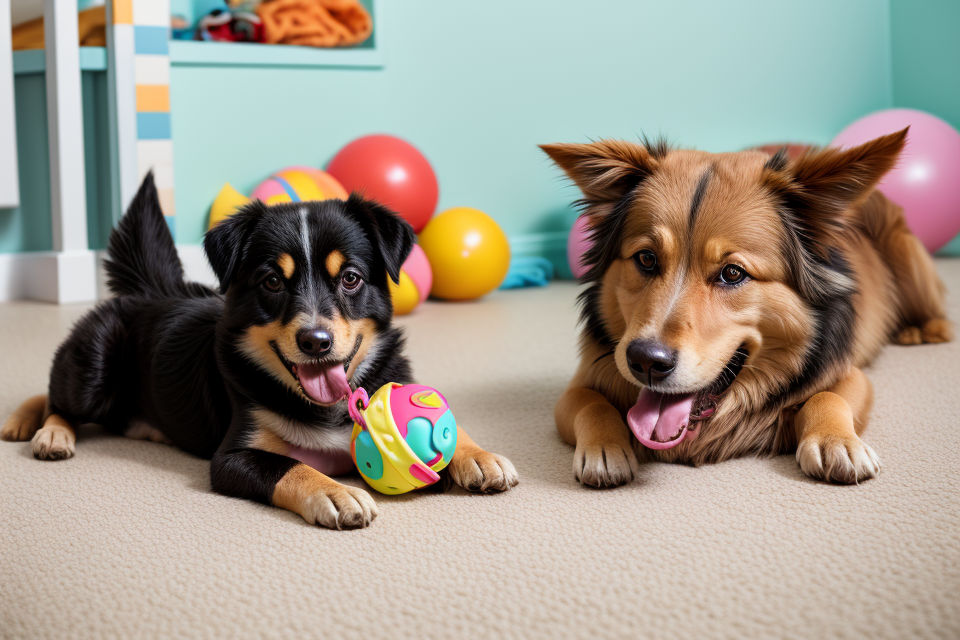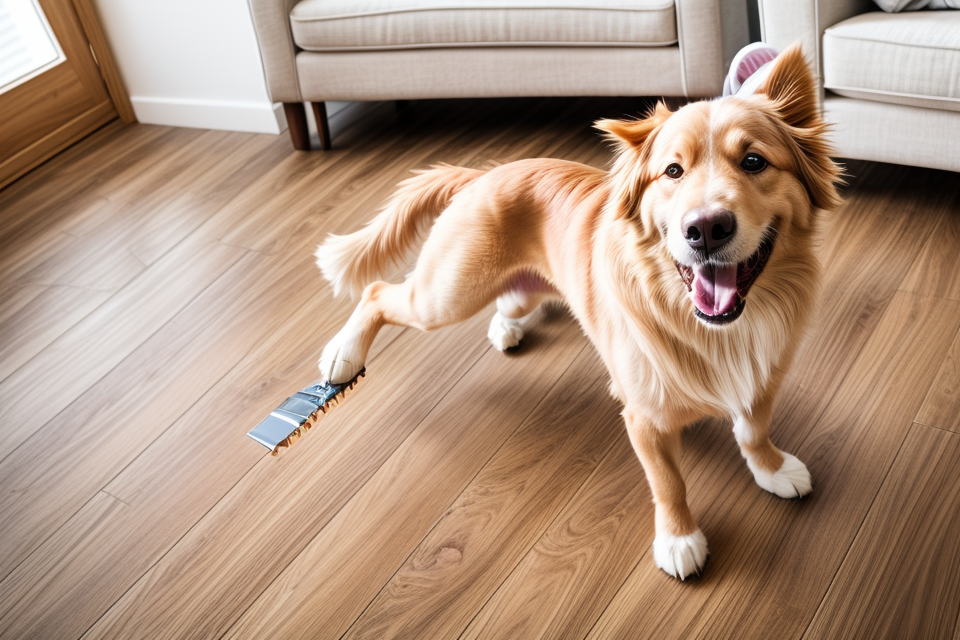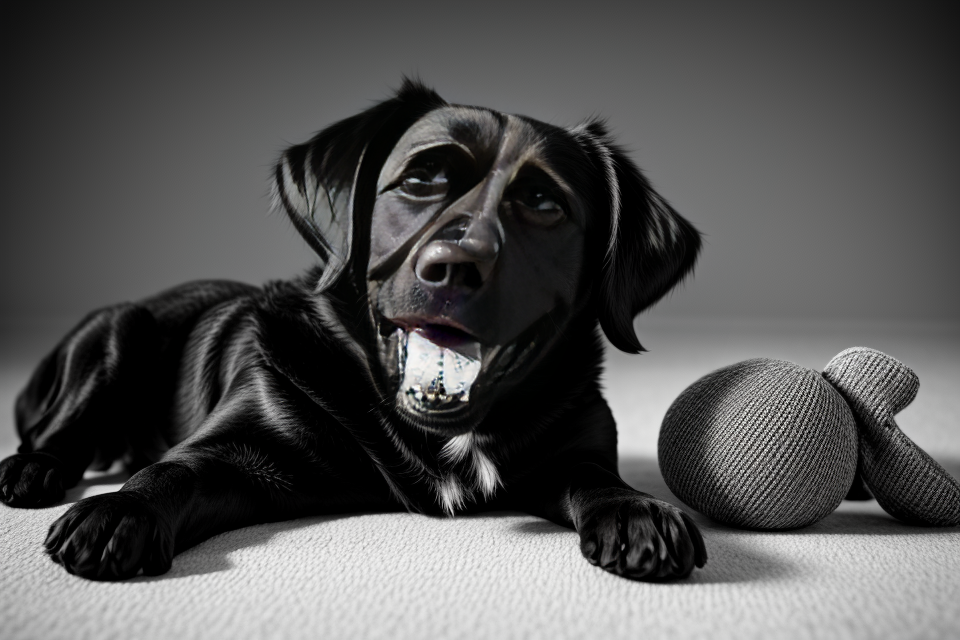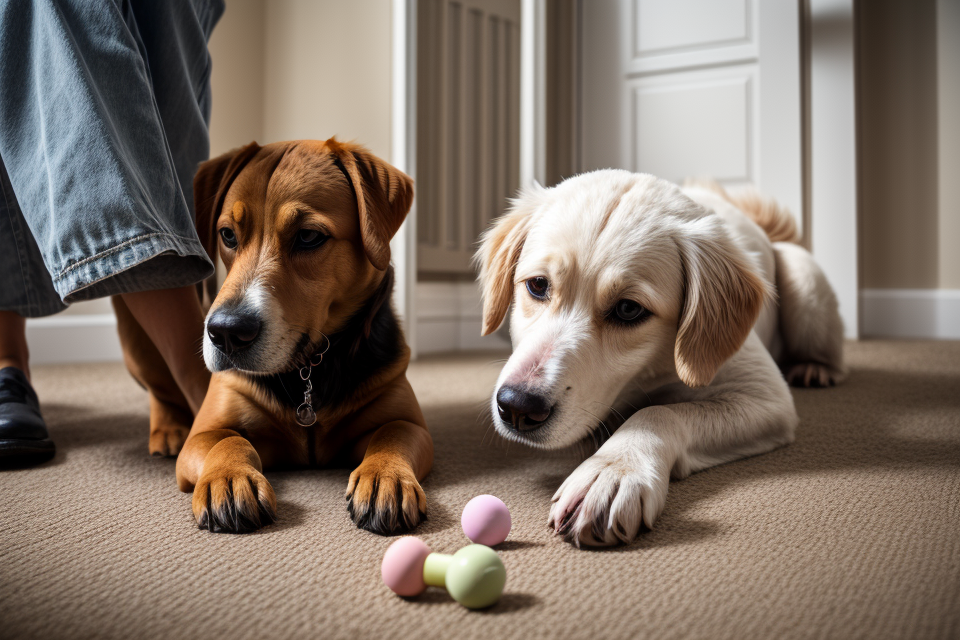Chew toys are a popular treat for dogs, but are they actually good for their health and behavior? The answer is a resounding yes! Chewing on chew toys has many benefits for your furry friend, from reducing anxiety to strengthening their teeth and gums. In this article, we’ll explore the ins and outs of chew toys and how they can improve your dog’s overall well-being. So, whether you’re a first-time dog owner or a seasoned pro, read on to discover why chew toys are a must-have for your pup.
Yes, chewing on chew toys is good for your dog’s health and behavior. Chewing on chew toys can help to reduce the risk of dental problems by removing plaque and tartar from your dog’s teeth. It can also help to alleviate boredom and provide mental stimulation, which can help to prevent destructive behavior. Additionally, chewing on chew toys can help to satisfy your dog’s natural instinct to chew, which can help to reduce the likelihood of them chewing on inappropriate items. It is important to provide your dog with a variety of chew toys made from different materials, such as rubber, nylon, and rope, to keep them interested and to prevent them from becoming bored with one type of toy.
Understanding Dog Chewing Behavior
Why Do Dogs Chew?
Dogs chew for a variety of reasons, some of which are deeply ingrained in their basic instincts, while others are driven by environmental factors. Understanding these reasons can help dog owners provide appropriate outlets for their pets’ chewing behavior and promote better health and well-being.
- Basic instincts: Dogs have a natural inclination to chew as a way to explore and interact with their environment. This behavior is often seen in puppies, who use their teeth to examine and manipulate toys and other objects. As dogs age, they may continue to chew as a way to relieve boredom or satisfy their instinctual need to tear apart and consume objects.
- Teething: Puppies, in particular, may engage in excessive chewing as a way to relieve the discomfort associated with teething. The act of chewing can provide relief for sore gums and help to stimulate the production of saliva, which can help to soothe inflamed gums.
- Anxiety and stress relief: Dogs may chew as a way to cope with anxiety or stress. This behavior is often seen in dogs who are left alone for extended periods of time or who are separated from their owners. Chewing can provide a distraction and help to alleviate feelings of boredom, frustration, or stress.
- Exercise of jaw muscles: Like humans, dogs need to exercise their jaw muscles to maintain strong and healthy teeth and gums. Chewing on toys or other objects can provide the necessary stimulation to keep these muscles strong and healthy.
It is important for dog owners to understand the reasons behind their pets’ chewing behavior and to provide appropriate outlets for this behavior. By providing dogs with appropriate chew toys, owners can help to satisfy their pets’ natural instincts, alleviate anxiety and stress, and promote healthy jaw muscle development.
The Pros and Cons of Chewing
Dogs are natural chewers, and their desire to gnaw on things is a normal part of their behavior. However, there are both pros and cons to chewing behavior that pet owners should be aware of.
Pros:
- Oral health: Chewing can help keep your dog’s teeth clean and promote healthy gums. This is especially important for dogs who do not have access to a balanced diet or dental treats.
- Mental stimulation: Chewing provides mental stimulation for dogs, which can help reduce boredom and prevent destructive behavior.
- Satisfaction of instincts: Chewing is a natural instinct for dogs, and providing them with appropriate chew toys can help satisfy this instinct in a healthy way.
Cons:
- Destructive behavior: If your dog is not provided with appropriate chew toys, they may resort to chewing on other things in the house, such as furniture or shoes, which can be destructive.
- Aggression: Chewing can also be a sign of stress or anxiety in dogs. If your dog is excessively chewing, it may be a sign of an underlying issue that needs to be addressed.
- Excessive chewing: If your dog is chewing on everything in sight, it may be a sign that they are not getting enough mental or physical stimulation. It is important to provide your dog with a variety of chew toys and other forms of enrichment to keep them happy and healthy.
Overall, the pros of chewing behavior far outweigh the cons, but it is important to monitor your dog’s chewing habits and provide them with appropriate chew toys to prevent destructive behavior and ensure their overall health and well-being.
The Importance of Chew Toys for Dogs
Providing a Safe Outlet for Chewing
Chewing is a natural behavior for dogs, and it serves several important purposes. Chewing helps to relieve stress, alleviate boredom, and satisfy their instinctual desire to chew. However, it is important to provide a safe outlet for this behavior, as chewing on the wrong things can lead to destructive behavior towards household items, dental problems, and even health issues.
One of the main benefits of providing chew toys for dogs is that it can help to prevent destructive behavior towards household items. When dogs are left to their own devices, they may resort to chewing on furniture, shoes, or other items in the home. This can be destructive and costly, and it can also lead to behavioral problems such as separation anxiety. By providing chew toys, you can redirect your dog’s natural chewing instincts towards a more appropriate target.
Another benefit of chew toys is that they can help to reduce the risk of dental problems. Chewing on hard toys can help to remove tartar and plaque from the teeth, which can prevent the development of dental problems such as gum disease and tooth decay. It is important to choose chew toys that are appropriate for your dog’s size and chewing strength, as some toys can be too hard or too soft for certain dogs.
Finally, chew toys can also help to maintain a healthy weight in dogs. Many dogs who are overweight or obese suffer from a lack of exercise and a tendency to overeat. By providing chew toys that are filled with treats or puzzles, you can help to satisfy your dog’s appetite and provide them with the mental stimulation they need to stay engaged and active.
Types of Chew Toys
Chew toys are an essential part of a dog’s life as they provide mental and physical stimulation, which can help reduce anxiety and prevent destructive behavior. There are several types of chew toys available in the market, each designed to meet the unique needs and preferences of dogs.
Soft and Plush Chew Toys
Soft and plush chew toys are made from soft materials such as cloth, fleece, or rope. They are perfect for dogs who love to chew but are gentle on their teeth and gums. These toys are also great for dogs who love to cuddle and snuggle.
Rope and Rope-like Toys
Rope and rope-like toys are made from natural or synthetic fibers, such as cotton, nylon, or polyester. They are designed to be durable and long-lasting, providing dogs with hours of chewing fun. These toys are also great for dogs who love to play tug-of-war.
Hard and Rubber Chew Toys
Hard and rubber chew toys are made from materials such as rubber, silicone, or hard plastic. They are designed to be tough and durable, providing dogs with a challenge when it comes to chewing. These toys are also great for dogs who love to play fetch or catch.
Interactive and Puzzle Toys
Interactive and puzzle toys are designed to challenge dogs mentally and physically. They may contain hidden treats or compartments that dogs need to figure out how to access. These toys are great for dogs who love to problem-solve and use their brains.
Overall, chew toys are an essential part of a dog’s life, providing them with the mental and physical stimulation they need to stay happy and healthy. By choosing the right type of chew toy for your dog, you can help prevent destructive behavior and keep your furry friend entertained for hours on end.
The Effects of Chew Toys on Dog Health and Behavior
Short-Term Effects
- Reduced chewing on inappropriate items
- When dogs are given appropriate chew toys, they are less likely to chew on other items such as furniture, shoes, or clothes, which can cause damage or create health hazards.
- Providing dogs with a variety of chew toys can help satisfy their natural instinct to chew, reducing the likelihood of destructive behavior.
- Mental stimulation and satisfaction
- Chew toys provide mental stimulation for dogs, which can help prevent boredom and reduce the likelihood of destructive behavior caused by under-stimulation.
- Chewing on chew toys can also satisfy a dog’s natural instinct to explore and manipulate their environment, providing a sense of satisfaction and reducing stress.
- Reduced anxiety and stress
- Chewing on chew toys can help alleviate anxiety and stress in dogs by providing a safe outlet for their natural instinct to chew.
- Chew toys can also provide a sense of security and comfort for dogs, particularly those who are anxious or stressed due to changes in their environment or routine.
Overall, the short-term effects of chew toys on dogs include reduced chewing on inappropriate items, mental stimulation and satisfaction, and reduced anxiety and stress. Providing dogs with appropriate chew toys can help improve their behavior and overall well-being.
Long-Term Effects
- Reduced risk of dental problems:
- Regular chewing on chew toys can help remove plaque and tartar buildup, reducing the risk of gum disease and tooth decay in dogs.
- Chew toys can also help keep your dog’s teeth clean by acting as a natural toothbrush, which can lead to healthier gums and fresher breath.
- Stronger jaw muscles:
- Chewing on chew toys can help strengthen your dog’s jaw muscles, providing them with the necessary exercise to maintain a healthy and strong jaw.
- This can help prevent issues such as malocclusion, where the teeth do not align properly, which can lead to oral health problems and pain.
- Improved behavior and less destructive chewing:
- Providing your dog with appropriate chew toys can redirect their natural instinct to chew onto items that are safe and non-destructive.
- This can help reduce the likelihood of your dog chewing on furniture, shoes, or other household items, which can be harmful to their health and disruptive to your home.
- Chew toys can also provide mental stimulation, helping to satisfy your dog’s natural curiosity and reducing the likelihood of destructive behavior due to boredom.
Selecting the Right Chew Toy for Your Dog
Considerations for Choosing a Chew Toy
When selecting a chew toy for your dog, there are several considerations to keep in mind to ensure that the toy is appropriate for your pet’s size, chewing strength, habits, durability, and safety.
Size and shape of the dog
The size and shape of the dog are important factors to consider when choosing a chew toy. Smaller dogs may have difficulty handling large chew toys, while larger dogs may become bored with small ones. It is important to choose a chew toy that is appropriate for your dog’s size to prevent choking or other injuries.
Chewing strength and habits
The chewing strength and habits of your dog are also important considerations when choosing a chew toy. Some dogs are powerful chewers and may require a more durable chew toy, while others may be satisfied with a softer option. If your dog has a history of chewing on inappropriate items, such as shoes or furniture, a chew toy may be an effective way to redirect their chewing habits.
Durability and safety
The durability and safety of the chew toy are also important factors to consider. Some chew toys are made from tough materials that can withstand heavy chewing, while others may break apart easily. It is important to choose a chew toy that is safe for your dog and cannot be easily broken apart and swallowed.
Price and affordability
Finally, the price and affordability of the chew toy should also be considered. Chew toys can range in price from a few dollars to several dollars, depending on the type and quality of the toy. It is important to choose a chew toy that is affordable for you and that provides value for money.
Recommended Chew Toys for Different Dog Breeds and Chewing Styles
- Small dogs:
- KONG: A hollow rubber toy that can be stuffed with treats or peanut butter for added interest. It’s designed to be durable and safe for dogs to chew on.
- Rope toys: Made from materials like cotton or nylon, these toys are soft enough for small dogs to chew on without causing harm.
- Rubber toys: Soft rubber toys that are designed to be chewed on and can be filled with treats or peanut butter for added interest.
- Large dogs:
- Nylon bones: Long-lasting chew toys made from nylon that are designed to be tough and durable for powerful chewers.
- Hard rubber toys: Toys made from hard rubber that are designed to be chewed on and can be filled with treats or peanut butter for added interest.
- Interactive toys: Toys that are designed to be filled with treats or peanut butter and dispensed as the dog chews on them. They often have different sections to keep the dog engaged.
- Power chewers:
- Super durable rubber toys: Toys made from extra-tough rubber that are designed to withstand even the strongest of chewers.
- Rope toys with stuffed toys: Rope toys that have a stuffed animal or other toy attached to them for added interest and challenge.
By selecting the right chew toy for your dog based on their breed and chewing style, you can provide them with a safe and engaging way to satisfy their natural instinct to chew while also promoting their dental health and mental stimulation.
Encouraging Healthy Chewing Habits in Dogs
Training Your Dog to Use Chew Toys
- Introducing chew toys early
It is recommended to introduce chew toys to your dog at an early age, preferably when they are puppies. This will help them get used to the taste and texture of the toys, and make it a normal part of their daily routine. You can start by giving them small, soft chew toys that are easy to chew and swallow.
- Offering chew toys as a reward
One of the most effective ways to encourage your dog to chew on chew toys is to offer them as a reward for good behavior. For example, if your dog is well-behaved during a walk, you can give them a chew toy as a reward. This will associate chew toys with positive experiences, and encourage your dog to chew on them more often.
- Gradually transitioning to tougher chew toys
As your dog gets older and their teeth get stronger, you can gradually transition them to tougher chew toys. This will help prevent them from chewing on other objects in your home, such as furniture or shoes. Start with soft chew toys and gradually work your way up to harder ones, such as nylon bones or ropes.
- Providing appropriate chew toys when your dog is bored or anxious
Chewing on chew toys can also be a great way to keep your dog entertained and reduce their stress levels. If you notice that your dog is bored or anxious, provide them with appropriate chew toys to keep them occupied. This can help prevent destructive chewing behaviors, such as chewing on furniture or shoes.
Creating a Chew Toy Rotation
Creating a chew toy rotation is an effective way to encourage healthy chewing habits in dogs. This involves regularly mixing up the types of chew toys available to your dog and rotating between different chew toys to keep them interested. By offering new chew toys, you can help satisfy your dog’s natural instinct to chew while also preventing them from becoming bored with the same old toys.
One key aspect of creating a chew toy rotation is to mix up the types of chew toys available to your dog. This means offering a variety of chew toys made from different materials, such as rubber, rope, and nylon. It’s also important to consider the size and shape of the chew toys, as some dogs may prefer larger or smaller toys. By providing a range of options, you can help ensure that your dog always has something new and interesting to chew on.
Another important aspect of creating a chew toy rotation is to rotate between different chew toys. This means regularly replacing old chew toys with new ones to keep your dog interested and engaged. If your dog becomes bored with a particular chew toy, they may start chewing on other things, such as furniture or shoes. By rotating between different chew toys, you can help prevent this behavior and keep your dog’s chewing habits focused on appropriate items.
Offering new chew toys is also an important part of creating a chew toy rotation. This can help keep your dog interested and engaged, as well as providing them with the mental stimulation they need to stay happy and healthy. When introducing new chew toys, it’s important to supervise your dog to ensure they use them appropriately and don’t become injured.
Finally, it’s important to retire chew toys when they become damaged or no longer stimulating. If a chew toy becomes worn or damaged, it may become a choking hazard or cause your dog to become bored with it. By retiring damaged chew toys and replacing them with new ones, you can help prevent these issues and keep your dog’s chewing habits healthy and safe.
Addressing Excessive Chewing
Dogs naturally have a strong desire to chew, as it helps to keep their teeth and jaws strong. However, excessive chewing can be a sign of underlying issues such as anxiety or boredom. To address excessive chewing, there are several steps that dog owners can take:
- Addressing underlying issues: Excessive chewing can be a symptom of a larger problem, such as anxiety or boredom. Before attempting to address the chewing behavior directly, it’s important to identify and address any underlying issues that may be contributing to the behavior. This may involve providing additional exercise and mental stimulation, or making changes to the dog’s environment or routine.
- Increasing exercise and mental stimulation: Dogs who are physically and mentally stimulated are less likely to engage in destructive chewing behaviors. Providing opportunities for exercise, such as walks or playtime, and engaging in interactive games or puzzles can help to keep dogs mentally stimulated and satisfied.
- Gradually transitioning to tougher chew toys: Once a dog has mastered chewing on soft or easily destroyed toys, it’s important to gradually transition them to tougher chew toys that will provide more of a challenge. This can help to prevent boredom and destructive chewing behaviors.
- Consulting a veterinarian or certified animal behaviorist for professional advice: If excessive chewing persists despite efforts to address underlying issues and provide additional exercise and mental stimulation, it may be helpful to consult with a veterinarian or certified animal behaviorist. These professionals can provide guidance on how to address the behavior and help to identify any underlying medical or behavioral issues that may be contributing to the chewing behavior.
FAQs
1. What are chew toys and why are they beneficial for dogs?
Chew toys are specially designed products that are meant to be chewed by dogs. They are usually made from materials like rubber, nylon, or rope, and are designed to help satisfy a dog’s natural instinct to chew while also providing mental stimulation and preventing boredom. Chew toys can help keep a dog’s teeth clean, strengthen their jaws, and provide them with a healthy outlet for their energy and curiosity.
2. Are all chew toys safe for dogs to chew on?
No, not all chew toys are safe for dogs to chew on. Some chew toys may contain harmful chemicals or materials that can be toxic to dogs if ingested. It’s important to choose chew toys that are specifically designed for dogs and made from safe, non-toxic materials. It’s also important to monitor your dog while they are chewing on a chew toy to ensure that they don’t accidentally swallow any small pieces.
3. How long can a dog chew on a chew toy before it gets destroyed?
The durability of a chew toy can vary depending on the material it’s made from and the size of the dog. Some chew toys are designed to be indestructible and can withstand a lot of chewing from larger dogs. Other chew toys may not be as durable and may need to be replaced more frequently. It’s important to supervise your dog while they are chewing on a chew toy and to replace it if it becomes damaged or if your dog is able to break it into small pieces.
4. Can chew toys help with separation anxiety in dogs?
Yes, chew toys can be a helpful tool for dogs who suffer from separation anxiety. Chewing on a chew toy can provide a dog with a sense of security and comfort, especially when they are feeling anxious or stressed. However, it’s important to note that chew toys should not be used as a substitute for proper training and socialization to address separation anxiety. If your dog has severe separation anxiety, it’s best to consult with a veterinarian or a certified animal behaviorist for professional guidance.
5. Can chew toys help with dental health in dogs?
Yes, chew toys can be beneficial for dental health in dogs. Chewing on a chew toy can help remove plaque and tartar from a dog’s teeth, which can help prevent dental problems like gum disease and bad breath. However, it’s important to note that chew toys should not be used as a substitute for regular dental care, such as brushing a dog’s teeth or taking them to the vet for professional cleanings. If you’re concerned about your dog’s dental health, it’s best to consult with your veterinarian.



